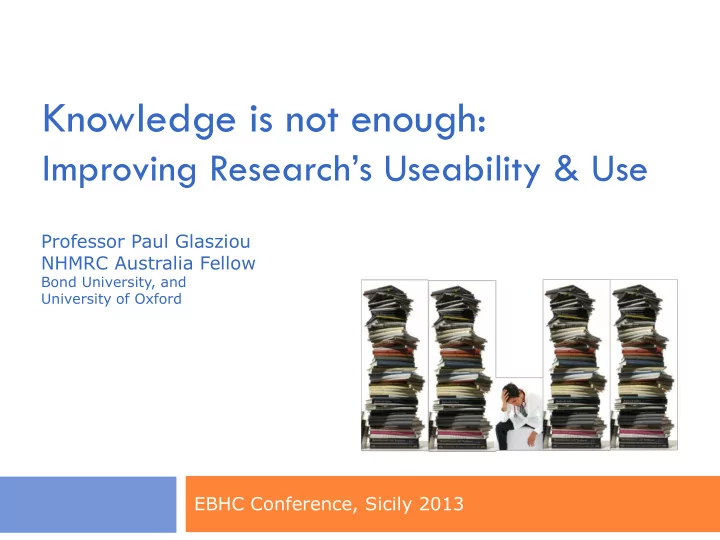

Knowledge is not enough: Improving Research’s Useability & Use Professor Paul Glasziou NHMRC Australia Fellow Bond University, and University of Oxford EBHC Conference, Sicily 2013
Can we keep up to date?
Can we keep up to date? 2012 But that was last year!
The “ half-life ” of knowledge Of 100 systematic reviews: Median time to a change that would effect clinical decisions was 5.5 years. 7 out of date when published Shojania Ann Intern Med, 2007
Warning: Most innovations don’t work Arthoscopic knee lavage (Moseley, NEJM, 2002) Blood glucose monitoring for non-insulin dependent diabetes (DiGEM trial, BMJ 2007) Vertebroplasty for osteoporotic fractures (NEJM, 2010) Tight control of diabetes (ACCORD, NEJM, 2010) Prostate cancer screening (Djulbegovic, BMJ 2010) Ovarian cancer screening (JAMA, 2011) Lung Cancer Screening (NEJM, 2011) Telemonitoring elderly patients at high risk (Takahashi, Arch Intern Med, 2012)
Some variants of Evidence-Based Practice Yaser Faden, Bob Phillips, Richard Nicholl Oncology, Leeds Neonatology, Patients in Trials Jeddeh & London “PICO” rounds Martin Burton GP Practice ENT, Oxford Beaumont St Oxford
Layers of research information 11 meta-analyses/day 95 trials/day Haynes, ACPJC
Evidence-Based Paediatric Oncology Bob Phillips, Oncology, Leeds Patients in Trials 80-90% kids in clinical trials Compare current versus new Gradual improvement Rare cases with no trials
Most new treatments don’t work an analysis of 136 trials in myeloma Treatments Equal “These studies as well as our New New empirically confirm investigators Treatment Treatment Better often do not know in advance what Worse they will discover” Djulbegovic et al
Evidence-Based Perinatology
Questions from Ward Round Ward round -> questions Between rounds - -> look up Discuss at next ward round OR Journal Club (if major change)
Evidence-Based Primary Care Wide range of conditions (13,000!) No single evidence source Fortnightly “ Journal Club ” Logbooks of Clinical Questions
Frequency Other half for over 800 conditions Half GP consultations for 30 conditions Back Disorders Unspecified Joint disorder Other Unspecified Bronchitis Acute 100% 10% 20% 30% 40% 50% 60% 70% 80% 90% Hypertension 0% Symptoms, Respiratory & Chest External Ear Disorder Conjunctiva Disorder Asthma Urethral Urinary Tract Disorders Other Neurotic Disorders Core topics: Must know “Just in case” learning (almost) everything Tonsillitis Acute Pharyngitis Acute General Symptoms Skin & Integument Tissue Symptoms, Abdomen Pelvis Atopic Dermatitis Pain in Limb Contact Dermatitis & Eczema Peripheral Enthesopathies Otitis Media Nonsuppurative Osteoarthritis Sinusitis Acute Menstruation abnormal Must know some basics “Just in time” learning Allergic Rhinitis Sebaceous Gland Diseases Diabetes Mellitus Illdefined Intestinal Infections Candidiasis Otitis Media Suppurative Dermatophytosis 800 Other
The scatter of trials & metaanalyses Neurological research in 2009 2,770 randomized trials in 900 journals • 547 systematic reviews in 290 journals • Hoffmann et al BMJ 2012
Use an evidence-based update service McMaster Plus Processes Number Needed to Read 140+ journals scanned to find 1 valid is 20+ • – 60,000 articles Is it valid ? (<5%) • – Intervention: RCT – Prognosis: inception cohort – Etc Is it relevant? Number Needed to Read • – 6-12 GPs & specialists asked: to find 1 valid & relevant is 200+ Relevant? Newsworthy? < 0.5% selected • http://hiru.mcmaster.ca/hiru/HIRU_McMaster_PLUS_projects.aspx
From knowledge to action: digesting the evidence REGULAR Fortnightly “Journal Club” Step 1 – 10 minutes Discuss new problems and topics (questions, EBM journal, guidelines) Step 2 – 40 minutes Read and appraise research paper for last weeks problem Step 3 – 10 minutes Agree conclusions and “ next actions ” Organise changes in practice and follow up – who, what, when? Write to study authors for more details
The (missing) guidebook for IBS TRIAL: Self-help interventions in patients with a primary care diagnosis of irritable bowel syndrome. Gut 2006. At one year, patients in the guidebook group had a 60% reduction in primary care consultations (p=0.001) and a reduction in perceived symptom severity (p=0.001) compared with controls. PROBLEM: Missing details of guidebook. No response from author to 3 emails Colleague said booklet was on sale Google search found the book Price: £8.99
Descriptions in 80 treatment studies selected for EBM journal were often inadequate Description sufficient to replicate 100% 90% 80% 70% 60% Initial 50% Final 40% 30% 20% 10% 0% Overall Trials Meta- Drug Non drug analysis Glasziou et al BMJ, 2008
Problems in treatment descriptions of 133 non-drug trials in top 6 journals, 2009 2 100 100 % of interventions rated as adequately 98 90 45 9 7 After author contact 12 80 83 81 Initially 20 74 70 described 60 20 54 50 47 40 39 30 20 10 0 Setting Recipient Provider Procedure Materials Intensity Schedule Overall Individual checklist items and overall rating of completeness of the intervention description Hoffmann, Erueti, Glasziou BMJ 2013
Handbook of Non-Drug Interventions www.racgp.org.au/handi/
Follow up after journal clubs: The Epley for BPPV (Vertigo) STUDY: Self-treatment for benign paroxysmal positional vertigo of the posterior semicircular canal. Neurology 2005. TREATMENT: “ Each head position has to be maintained for more than 30 seconds. Patients received illustrated instructions for the specific maneuver … ” All agreed “useful” 3 months later only 2 doctors did it Put video in intranet Another 3 months later Still only 2 doctors Trained each person to do
Learning the “how to” of Epley 1.Bookmark the video (on YouTube) 2.Tip: watch with patient first!!
Conclusions: Use and Usability For each clinical discipline we need: Filtering of research: systematic reviews, EB-journals Summaries sufficient for decision making Details sufficient for implementation “Next Actions” after critical appraisal
Recommend
More recommend